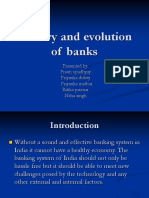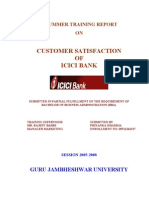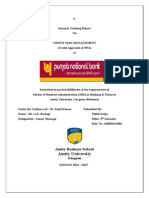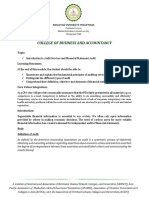0 ratings0% found this document useful (0 votes)
27 viewsBanking Seminar Report Sem 1
Banking Seminar Report Sem 1
Uploaded by
Farukh ShaikhThe document summarizes the evolution of banking in India from the 18th century to present day. It divides the history into 3 phases: (1) the early phase pre-1947 during British rule, (2) the nationalization phase from 1969-1991 when many private banks were nationalized, and (3) the post-1991 liberalization phase with banking reforms and the introduction of private banks. Nationalization led to increased access to banking in rural areas but the liberalization phase has made the sector more competitive and advanced through new technologies.
Copyright:
© All Rights Reserved
Available Formats
Download as DOCX, PDF, TXT or read online from Scribd
Banking Seminar Report Sem 1
Banking Seminar Report Sem 1
Uploaded by
Farukh Shaikh0 ratings0% found this document useful (0 votes)
27 views6 pagesThe document summarizes the evolution of banking in India from the 18th century to present day. It divides the history into 3 phases: (1) the early phase pre-1947 during British rule, (2) the nationalization phase from 1969-1991 when many private banks were nationalized, and (3) the post-1991 liberalization phase with banking reforms and the introduction of private banks. Nationalization led to increased access to banking in rural areas but the liberalization phase has made the sector more competitive and advanced through new technologies.
Copyright
© © All Rights Reserved
Available Formats
DOCX, PDF, TXT or read online from Scribd
Share this document
Did you find this document useful?
Is this content inappropriate?
The document summarizes the evolution of banking in India from the 18th century to present day. It divides the history into 3 phases: (1) the early phase pre-1947 during British rule, (2) the nationalization phase from 1969-1991 when many private banks were nationalized, and (3) the post-1991 liberalization phase with banking reforms and the introduction of private banks. Nationalization led to increased access to banking in rural areas but the liberalization phase has made the sector more competitive and advanced through new technologies.
Copyright:
© All Rights Reserved
Available Formats
Download as DOCX, PDF, TXT or read online from Scribd
Download as docx, pdf, or txt
0 ratings0% found this document useful (0 votes)
27 views6 pagesBanking Seminar Report Sem 1
Banking Seminar Report Sem 1
Uploaded by
Farukh ShaikhThe document summarizes the evolution of banking in India from the 18th century to present day. It divides the history into 3 phases: (1) the early phase pre-1947 during British rule, (2) the nationalization phase from 1969-1991 when many private banks were nationalized, and (3) the post-1991 liberalization phase with banking reforms and the introduction of private banks. Nationalization led to increased access to banking in rural areas but the liberalization phase has made the sector more competitive and advanced through new technologies.
Copyright:
© All Rights Reserved
Available Formats
Download as DOCX, PDF, TXT or read online from Scribd
Download as docx, pdf, or txt
You are on page 1of 6
Hirachand Nemchand College of Commerce,
Solapur
(Autonomous College)
MBA Section
Seminar Report
Name- Farukh Mehboob Shaikh
Std- MBA-I Sem-I
Div- Innovators
Roll No- 3254
Subject- Banking Operations and Services
Topic- Evolution of Banking in India
Evolution of Banking in India
Banking in India forms the base for the economic development of the country.
Major changes in the banking system and management have been seen over the
years with the advancement in technology, considering the needs of people.
The History of Banking in India dates back to before India got independence in
1947.
The banking sector development can be divided into three phases:
Phase I: The Early Phase which lasted from 1770 to 1969
Phase II: The Nationalisation Phase which lasted from 1969 to 1991
Phase III: The Liberalisation or the Banking Sector Reforms Phase which
began in 1991 and continues to flourish till date
Pre Independence Period (1786-1947)
The first bank of India was the “Bank of Hindustan”, established in 1770 and
located in the then Indian capital, Calcutta. However, this bank failed to work
and ceased operations in 1832.
During the Pre Independence period over 600 banks had been registered in the
country, but only a few managed to survive.
Following the path of Bank of Hindustan, various other banks were established
in India. They were:
The General Bank of India (1786-1791)
Oudh Commercial Bank (1881-1958)
Bank of Bengal (1809)
Bank of Bombay (1840)
Bank of Madras (1843)
During the British rule in India, the East India Company had established three
banks: Bank of Bengal, Bank of Bombay and Bank of Madras and called them
the Presidential Banks. These three banks were later merged into one single
bank in 1921, which was called the “Imperial Bank of India.”
The Imperial Bank of India was later nationalised in 1955 and was named The
State Bank of India, which is currently the largest Public sector Bank.
If we talk of the reasons as to why many major banks failed to survive during
the pre-independence period, the following conclusions can be drawn:
Indian account holders had become fraud-prone
Lack of machines and technology
Human errors & time-consuming
Fewer facilities
Lack of proper management skills
Following the Pre-Independence period was the post-independence period,
which observed some significant changes in the banking industry scenario and
has till date developed a lot.
Post Independence Period (1947-1991)
At the time when India got independence, all the major banks of the country
were led privately which was a cause of concern as the people belonging to
rural areas were still dependent on money lenders for financial assistance.
With an aim to solve this problem, the then Government decided to nationalise
the Banks. These banks were nationalised under the Banking Regulation Act,
1949. Whereas, the Reserve Bank of India was nationalised in 1949.
Candidates can check the list of Banking sector reforms and Acts at the linked
article.
Following it was the formation of State Bank of India in 1955 and the other 14
banks were nationalised between the time duration of 1969 to 1991. These were
the banks whose national deposits were more than 50 crores.
Given below is the list of these 14 Banks nationalised in 1969:
Allahabad Bank
Bank of India
Bank of Baroda
Bank of Maharashtra
Central Bank of India
Canara Bank
Dena Bank
Indian Overseas Bank
Indian Bank
Punjab National Bank
Syndicate Bank
Union Bank of India
United Bank
UCO Bank
In the year 1980, another 6 banks were nationalised, taking the number to 20
banks. These banks included:
Andhra Bank
Corporation Bank
New Bank of India
Oriental Bank of Comm.
Punjab & Sind Bank
Vijaya Bank
Apart from the above mentioned 20 banks, there were seven subsidiaries of SBI
which were nationalised in 1959:
State Bank of Patiala
State Bank of Hyderabad
State Bank of Bikaner & Jaipur
State Bank of Mysore
State Bank of Travancore
State Bank of Saurashtra
State Bank of Indore
All these banks were later merged with the State Bank of India in 2017, except
for the State Bank of Saurashtra, which merged in 2008 and State Bank of
Indore, which merged in 2010.
Impact of Nationalisation
There were various reasons why the Government chose to nationalise the banks.
Given below is the impact of Nationalising Banks in India:
This lead to an increase in funds and thereby increasing the economic
condition of the country
Increased efficiency
Helped in boosting the rural and agricultural sector of the country
It opened up a major employment opportunity for the people
The Government used profit gained by Banks for the betterment of the
people
The competition decreased, which resulted in increased work efficiency
This post Independence phase was the one that led to major developments in the
banking sector of India and also in the evolution of the banking sector.
Liberalisation Period (1991-Till Date)
Once the banks were established in the country, regular monitoring and
regulations need to be followed to continue the profits provided by the banking
sector. The last phase or the ongoing phase of the banking sector development
plays a hugely significant role.
To provide stability and profitability to the Nationalised Public sector Banks,
the Government decided to set up a committee under the leadership of Shri. M
Narasimham to manage the various reforms in the Indian banking industry.
The biggest development was the introduction of Private sector banks in India.
RBI gave license to 10 Private sector banks to establish themselves in the
country. These banks included:
Global Trust Bank
ICICI Bank
HDFC Bank
Axis Bank
Bank of Punjab
IndusInd Bank
Centurion Bank
IDBI Bank
Times Bank
Development Credit Bank
The other measures taken include:
Setting up of branches of the various Foreign Banks in India
No more nationalisation of Banks could be done
The committee announced that RBI and Government would treat both
public and private sector banks equally
Any Foreign Bank could start joint ventures with Indian Banks
Payments banks were introduced with the development in the field of
banking and technology
Small Finance Banks were allowed to set their branches across India
A major part of Indian banking moved online with internet banking and
apps available for fund transfer
Thus, the history of banking in India shows that with time and the needs of
people, major developments have been brought about in the banking sector with
an aim to prosper it.
You might also like
- Cashflow 101 Game CardsDocument17 pagesCashflow 101 Game Cardsgift10875% (12)
- Project ReportDocument57 pagesProject Reportadi6187100% (1)
- Regional Rural Banks of India: Evolution, Performance and ManagementFrom EverandRegional Rural Banks of India: Evolution, Performance and ManagementNo ratings yet
- History and Evolution of BanksDocument10 pagesHistory and Evolution of BanksDr-Shefali GargNo ratings yet
- History of Indian BanksDocument4 pagesHistory of Indian BanksVignesh IyerNo ratings yet
- 1.1 Nature and History of BankingDocument24 pages1.1 Nature and History of Bankingsuryanarayandas1994No ratings yet
- History of Banking in IndiaDocument5 pagesHistory of Banking in IndiamylahNo ratings yet
- History of Banking in IndiaDocument32 pagesHistory of Banking in IndiaHedayatullah PashteenNo ratings yet
- History of Banking in India SlideDocument14 pagesHistory of Banking in India SlideDipak SinghNo ratings yet
- 1.1 Overview of Banking IndustryDocument51 pages1.1 Overview of Banking IndustryRohit PathakNo ratings yet
- Customer Satisfaction ICICI BankDocument96 pagesCustomer Satisfaction ICICI Bankvaishalipress1978No ratings yet
- BFSI Unit 1Document27 pagesBFSI Unit 1ras18092004No ratings yet
- Project On ICICI BankDocument104 pagesProject On ICICI BankVrinda KaushalNo ratings yet
- Q 1) Banking PDFDocument13 pagesQ 1) Banking PDFAnand maratheNo ratings yet
- Project On RBIDocument37 pagesProject On RBIghanshyamshukla4379% (14)
- Banking Anf Financial Institution Word FileDocument245 pagesBanking Anf Financial Institution Word FilevermahmaNo ratings yet
- Part 2Document70 pagesPart 2Ridhima MalhotraNo ratings yet
- History of Banking in India: Managing New ChallengesDocument14 pagesHistory of Banking in India: Managing New ChallengesPushpendra MittalNo ratings yet
- Bank Profile: Project ReportDocument19 pagesBank Profile: Project ReportClayton WilliamsNo ratings yet
- Indian Banking SystemDocument56 pagesIndian Banking SystemManoj YadavNo ratings yet
- Time-Value of Money - IciciDocument27 pagesTime-Value of Money - IciciJay PatelNo ratings yet
- Customer Satisfaction-ICICI BankDocument98 pagesCustomer Satisfaction-ICICI BankSabinYadav88% (16)
- Project: G I B SDocument26 pagesProject: G I B Srohit utekarNo ratings yet
- 2020 A STUDY ON RECRUITMENT AND SELECTION PROCESS Research Report HRDocument63 pages2020 A STUDY ON RECRUITMENT AND SELECTION PROCESS Research Report HRanjali sikhaNo ratings yet
- Icici Bank ProjectDocument70 pagesIcici Bank ProjectSonu Dhangar100% (2)
- E-BANKING SERVICE HDFC ProjectDocument65 pagesE-BANKING SERVICE HDFC ProjectSri KamalNo ratings yet
- Working Capital Management: The Technological Institute of Textile & Sciences, BhiwaniDocument24 pagesWorking Capital Management: The Technological Institute of Textile & Sciences, BhiwaniMohitNo ratings yet
- ZZZZDocument109 pagesZZZZnikhils88No ratings yet
- Industry Profile: Indian Banking SystemDocument78 pagesIndustry Profile: Indian Banking SystemManthan VashisthNo ratings yet
- Kinds of Banks and Their FunctionsDocument6 pagesKinds of Banks and Their Functionsmeenal sahuNo ratings yet
- History and Evolution of Banks - ExcerptDocument10 pagesHistory and Evolution of Banks - ExcerptroseavyNo ratings yet
- CCCCCCCCCC CDocument18 pagesCCCCCCCCCC Cprakashx3No ratings yet
- Customer Satisfaction IciciDocument69 pagesCustomer Satisfaction Icicimandiratta100% (1)
- FINAL - PROJECT Report On HSBCDocument72 pagesFINAL - PROJECT Report On HSBCgururaj77167% (3)
- Comparative Study of Education Loan Between Sbi and IciciDocument88 pagesComparative Study of Education Loan Between Sbi and IciciAvtaar SinghNo ratings yet
- Final Project Report - Docx Axis BankDocument73 pagesFinal Project Report - Docx Axis BankSuraj GhongeNo ratings yet
- History and Evolution of BanksDocument10 pagesHistory and Evolution of Bankssakshisrivastava100% (1)
- Jai Narian Vyas University, Jodhpur: Recent Development of Banking IndustryDocument32 pagesJai Narian Vyas University, Jodhpur: Recent Development of Banking IndustrymanasutharNo ratings yet
- Banking Reforms in IndiaDocument17 pagesBanking Reforms in IndiaTushar DashNo ratings yet
- History of Banking in IndiaDocument4 pagesHistory of Banking in IndiaNitin sharmaNo ratings yet
- Banking and MicrofinanceDocument33 pagesBanking and Microfinancebeena antuNo ratings yet
- Aaqib Final ProjectDocument58 pagesAaqib Final ProjectJkgi InstitutionsNo ratings yet
- Training and Dev. HDFC BankDocument58 pagesTraining and Dev. HDFC BankSudhir KakarNo ratings yet
- INTRODUCTndDocument30 pagesINTRODUCTndgamingdaddy8No ratings yet
- Bank Not of UK, Telangana Charitra, Telangana Coins, Telangana Language, Indian Banknote, Musham Damodhar, Banknotes Auction, Ancient Coins Auction, Bank of Bengal Half Notes AuctionDocument16 pagesBank Not of UK, Telangana Charitra, Telangana Coins, Telangana Language, Indian Banknote, Musham Damodhar, Banknotes Auction, Ancient Coins Auction, Bank of Bengal Half Notes Auctionmusham9No ratings yet
- Customer Preference Towards Private Vs Public Sector Banks During The Curren Ttime of RecessionDocument75 pagesCustomer Preference Towards Private Vs Public Sector Banks During The Curren Ttime of Recessionswatisabherwal80% (5)
- Unit-1 Business LawDocument22 pagesUnit-1 Business LawmihomemarchNo ratings yet
- A Study On CRM in Icici BankDocument64 pagesA Study On CRM in Icici BankDines.hadwale0% (1)
- History of Indian Banking SystemDocument4 pagesHistory of Indian Banking SystemDr. Navjyot RavalNo ratings yet
- Project Report ON Working Capital Management: Punjab National BankDocument65 pagesProject Report ON Working Capital Management: Punjab National BankSurender Dhuran PrajapatNo ratings yet
- Banking Sector Reforms in IndiaDocument76 pagesBanking Sector Reforms in Indialaxmi sambreNo ratings yet
- Ch.1 Indian Banking: IntroductionDocument54 pagesCh.1 Indian Banking: Introductiont1g2No ratings yet
- Banking India: Accepting Deposits for the Purpose of LendingFrom EverandBanking India: Accepting Deposits for the Purpose of LendingNo ratings yet
- T R A N S F O R M A T I O N: THREE DECADES OF INDIA’S FINANCIAL AND BANKING SECTOR REFORMS (1991–2021)From EverandT R A N S F O R M A T I O N: THREE DECADES OF INDIA’S FINANCIAL AND BANKING SECTOR REFORMS (1991–2021)No ratings yet
- Scaling New Heights: Vizag–Chennai Industrial Corridor, India's First Coastal CorridorFrom EverandScaling New Heights: Vizag–Chennai Industrial Corridor, India's First Coastal CorridorNo ratings yet
- Securitization in India: Managing Capital Constraints and Creating Liquidity to Fund Infrastructure AssetsFrom EverandSecuritization in India: Managing Capital Constraints and Creating Liquidity to Fund Infrastructure AssetsNo ratings yet
- Emerging Issues in Finance Sector Inclusion, Deepening, and Development in the People's Republic of ChinaFrom EverandEmerging Issues in Finance Sector Inclusion, Deepening, and Development in the People's Republic of ChinaNo ratings yet
- Total Quality Management FinalDocument27 pagesTotal Quality Management FinalFarukh ShaikhNo ratings yet
- Vijay PoM SeminarDocument9 pagesVijay PoM SeminarFarukh ShaikhNo ratings yet
- IAS Officer HR PresentationDocument12 pagesIAS Officer HR PresentationFarukh ShaikhNo ratings yet
- Economics Seminar Reprot Sem 1Document4 pagesEconomics Seminar Reprot Sem 1Farukh ShaikhNo ratings yet
- Banking Domain Knowledge For Business AnalystsDocument138 pagesBanking Domain Knowledge For Business Analystschotun99No ratings yet
- InvoiceDocument1 pageInvoiceAnonymous 2EHlltNo ratings yet
- MinggoyDocument12 pagesMinggoychantrealuna0No ratings yet
- About: Prudential PLCDocument8 pagesAbout: Prudential PLCMillton LucanoNo ratings yet
- Irdaa 11)Document19 pagesIrdaa 11)RHEANo ratings yet
- Assignment Accounting AJE GUIANGDocument14 pagesAssignment Accounting AJE GUIANGIce Voltaire B. GuiangNo ratings yet
- AT 06-07 Transaction Cycles Part 2Document12 pagesAT 06-07 Transaction Cycles Part 2EeuhNo ratings yet
- Notes On Internal ReconstructionDocument2 pagesNotes On Internal ReconstructionAli NadafNo ratings yet
- Updated CV Aakash Mishra 6336 (1) - 2Document3 pagesUpdated CV Aakash Mishra 6336 (1) - 2ShubhamNo ratings yet
- Bba201 Management & Cost Accounting Unit 1Document10 pagesBba201 Management & Cost Accounting Unit 1Divya Mishra100% (1)
- Direct Debit Request ("DDR")Document4 pagesDirect Debit Request ("DDR")Nicholson SmithNo ratings yet
- CL2014 07Document3 pagesCL2014 07Ron loyolaNo ratings yet
- SALUDARES, Jomar S. (ASSIGNMENT FINALS) - ME3B - (ES301-Engineering Economics) PDFDocument2 pagesSALUDARES, Jomar S. (ASSIGNMENT FINALS) - ME3B - (ES301-Engineering Economics) PDFJohn A. CenizaNo ratings yet
- Challan FormDocument1 pageChallan FormAnonymous 0izsN2No ratings yet
- BIOCON Case StudyDocument5 pagesBIOCON Case StudyShreya AnturkarNo ratings yet
- Keseluruhan Jurnal - Shiny SalonDocument2 pagesKeseluruhan Jurnal - Shiny SalonbaiqdevisandrianaNo ratings yet
- Invoice To Kimbraly A Hostetter - #96-935975Document1 pageInvoice To Kimbraly A Hostetter - #96-935975Imalka PriyadarshaniNo ratings yet
- Statement of Account: Date Narration Chq./Ref - No. Value DT Withdrawal Amt. Deposit Amt. Closing BalanceDocument22 pagesStatement of Account: Date Narration Chq./Ref - No. Value DT Withdrawal Amt. Deposit Amt. Closing BalanceRohit RajagopalNo ratings yet
- Investment and Securities AssignmentDocument16 pagesInvestment and Securities Assignmentkhusboo kharbandaNo ratings yet
- Final HDFC Training ReportDocument88 pagesFinal HDFC Training Reportshree BalajiNo ratings yet
- Zero Only: Application For Funds Transfer Under Rtgs/NeftDocument1 pageZero Only: Application For Funds Transfer Under Rtgs/NeftHemanth KumarNo ratings yet
- Account - Statement - 1120004322207 - 01 April 2020-30 April 2020 - 202006241504 PDFDocument5 pagesAccount - Statement - 1120004322207 - 01 April 2020-30 April 2020 - 202006241504 PDFAntonNo ratings yet
- Death 2024 SPCC PDFDocument24 pagesDeath 2024 SPCC PDFDaksh YadavNo ratings yet
- Ebook Compendium PDIC Final 2013Document232 pagesEbook Compendium PDIC Final 2013Raymond VallejoNo ratings yet
- 1 Financial SystemDocument13 pages1 Financial SystemAlbert CobicoNo ratings yet
- Plastic Money: Subject - Financial ServicesDocument24 pagesPlastic Money: Subject - Financial Servicesshashikumarb2277No ratings yet
- Module 2 - Introduction To FS AuditDocument5 pagesModule 2 - Introduction To FS AuditLysss EpssssNo ratings yet
- Haig Company Maintains A Petty Cash Fund For Small ExpendituresDocument1 pageHaig Company Maintains A Petty Cash Fund For Small ExpendituresAmit PandeyNo ratings yet
- CS2095281818072023 1Document5 pagesCS2095281818072023 1ganeshramarajuNo ratings yet





























































































